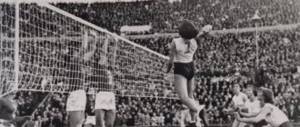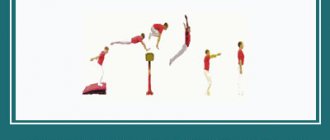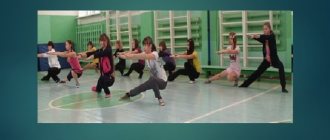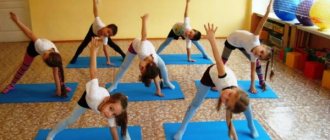Summary of an athletics lesson on the topic “Bending long jump with a run”
Subject:
"Running long jump while bending over."
Goal: Increasing the level of preparedness of students when mastering the technical elements of performing long jumps
Lesson objectives:
Educational objectives (subject results)
1.Introduce the technique of long jumping with a running bend
2.Reinforce the concepts of motor actions.
3. Strengthen the health of students through the development of physical qualities, coordination, and strength abilities.
Developmental tasks (meta-subject results):
1. Develop the ability to adequately assess one’s own behavior and the behavior of others (communicative UUD).
2. Develop the ability to highlight and formulate what has been learned and what needs to be learned, to determine the quality and level of knowledge assimilation (regulatory UUD).
3. Develop the ability to make the necessary adjustments to an action after its completion based on its assessment and taking into account the mistakes made (regulatory UUD).
4.Develop the ability to perform simple basketball moves at a high quality level (cognitive UUD).
Educational objectives (personal results):
1.Form independence and personal responsibility for one’s actions, an attitude toward a healthy lifestyle (self-determination, personal control measures).
2. Form motivation for educational activities (meaning formation, personal learning activities).
3. Develop cooperation skills in different situations, the ability not to create conflicts and find ways out of controversial situations. (moral and ethical orientation, personal UUD).
Inventory:
measuring tape, stands, sand pit
Location:
gym
Physical education lesson plan for 9th grade (running long jump)
Summary of an athletics lesson on the topic “Long jump with a bent run” Topic: “Long jump with a bent run.” Goal: Increasing the level of preparedness of students when mastering the technical elements of performing long jumps
Lesson objectives:
Educational objectives (subject results)
1.Introduce the technique of long jumping with a running bend
2.Reinforce the concepts of motor actions.
3. Strengthen the health of students through the development of physical qualities, coordination, and strength abilities.
Developmental tasks (meta-subject results):
1. Develop the ability to adequately assess one’s own behavior and the behavior of others (communicative UUD).
2. Develop the ability to highlight and formulate what has been learned and what needs to be learned, to determine the quality and level of knowledge assimilation (regulatory UUD).
3. Develop the ability to make the necessary adjustments to an action after its completion based on its assessment and taking into account the mistakes made (regulatory UUD).
4.Develop the ability to perform simple basketball moves at a high quality level (cognitive UUD).
Educational objectives (personal results):
1.Form independence and personal responsibility for one’s actions, an attitude toward a healthy lifestyle (self-determination, personal control measures).
2. Form motivation for educational activities (meaning formation, personal learning activities).
3. Develop cooperation skills in different situations, the ability not to create conflicts and find ways out of controversial situations. (moral and ethical orientation, personal UUD).
Equipment: plank, racks, gymnastic mats
Venue: gym
Physical education lesson summary Athletics Federal State Educational Standard UUD
| Lesson content | Dosage | Organizational and methodological instructions | Universal learning activities |
| |||
| Construction. Submission of the report. Greetings to the class. Reporting the topic and objectives of the lesson. Checking homework: § 20, p. 157-163 | 2 minutes | Pay attention to sports uniform, adherence to discipline, additional questions and explanations during the survey | The ability to formulate the purpose of the lesson, set tasks Communicative competencies: know how to interact with people around them, methods of action in communication situations, monitor each other’s safety Health-saving competencies: know how to use |
| Drill training: changing formations from one line to two and three on a count | 0.5 min | Pay attention to the correct order of execution | |
Walking in a column one at a time:
| 2 minutes | Pay attention to the position of your head, shoulders, back | |
Running with tasks in a column one at a time
| 3 min | Monitor breathing, correct posture when running - higher hips - more frequent movements - alignment in a line - as quickly as possible | |
| Formation into a column of two in motion to carry out outdoor switchgear | 0.5 min | Monitor the marching step and the technique of changing lanes | |
ORU complex without objects 1. I. p. - stand with your feet together, hands clasped (“locked”) below. 1-2 - arms up (palms up), rise on your toes and stretch (inhale); 3-4 - separating the fingers, arc the arms downwards and return to i. n. (exhale).
| 5 – 7min | Stretching out, raise your head and look at your hands. Raise your arms along the body. Complete the rotation of the torso until the end of the tilt. Make sure your legs remain straight and do not move. Perform the exercise with straight arms, without stopping at the bottom. When bending, secure the shoulder girdle. Breathing is voluntary. Sequence of execution: put your leg back, go down on your knee; put your other leg down and sit on the floor to the side; straighten your legs forward. Get up, doing the movements in reverse order. Sit alternately on the left and then on the right. Breathing is uniform. When jerking, do not lower your arms (keep them at shoulder height), your back is straight. When bending, your legs are straight and your toes are pointed. Increase the amplitude of movements gradually. Raise your body at the same time, actively tensing the muscles of your back and legs. Breathing is voluntary. In a bent position, short-term breath holding is possible. The middle circles are performed only with the forearms, fixing the shoulders and elbows. Change the direction of movements after several repetitions. Breathing is uniform. Each position must be clearly marked. Perform leg movements vigorously. Do not raise your head from the floor. Breathing is uniform. When performing the exercise, do not strain your body (only your arms work). Boys can later perform this exercise on two counts. Perform turns alternately, making several turns in each direction. Determine the magnitude of the turn in advance, for example, 8 turns of 90° in one direction and then the other, or 4 turns of 180°, etc. Jump softly, on your toes. Breathing is uniform. | |
| |||
| 1. The main running long jump for students is a jump using the “bent legs” method. Jump training is necessary. A running long jump using the “bent legs” method is performed with eleven to thirteen running steps. The general pattern of movements established in the junior grades continues to be refined and improved. All phases of the long jump are worked out in more detail: run-up, take-off, flight and landing. You begin repeating the long jump with standing jumps, then with a short run-up of one - three, three - five, five - seven, seven - nine, nine - eleven and eleven - thirteen steps. The running long jump using the “bent over” method is recommended for those practicing who do not have a strong enough take-off. This method is characterized by lowering the fly leg down and back in flight, followed by bending of the body. This position allows you to stretch the muscles of the front surface of the body and thereby create conditions for a good grouping of the jumper and throwing the legs far forward. The running long jump using the scissors method is a more rational way to jump long. It allows the jumper to reduce preparation for take-off and maintain balance in flight. This variant is characterized by the performance of movements in the flight phase, similar to movements when running. | 10-15 min | The teacher demonstrates the technique of performing a running long jump using the “bent legs” method. Monitor the execution technique. The main mistakes in long jumps (typical of all methods) and ways to correct them: 1. Excessively tense run-up. The reason is deficiencies in running technique. Remedies - special exercises for runners (running with acceleration, running on the move for various segments). 2. Increasing the length of the last steps before take-off. The reason is insufficient take-off speed, uncertainty in getting to the take-off point. The remedies are the same as for the previous error.
The reason is a misconception about the repulsion technique. Remedies - re-explaining the push-off technique, simulating a take-off from a short run.
| The ability to control and correct your own actions and the actions of classmates. The ability to make the necessary adjustments to an action after its completion based on its evaluation and taking into account errors made. The ability to control and correct your own actions and the actions of classmates. |
| Cleaning equipment into storage area | 30 sec | Classroom attendants, carefully | |
| 3. Jump relay. Teams line up in columns in front of the jumping pit and compete in performing the following jumps: a) over a designated obstacle (cone, medicine ball, gymnastic bench, rubber cord, mat, etc. b) over double and triple obstacles (benches, plinths, cubes); c) from the control line to the best result | 10 min | Participants must simultaneously take a run-up and push off from the block or from a designated place. For the correct execution of the jump - one point. The team with the most points wins. When holding competitions in the gym, lines drawn on the floor can serve as obstacles | |
| III. Final part 3-4 minutes | |||
1. Exercises to calm down, to form correct postureEx. “Butterfly” sitting on your knees, arms down, hands behind your back, palms together. Then, turning your folded hands with your fingers up, position your hands so that the entire length of your little fingers touches your spine.
| 3 min | The exercises are performed on gymnastic mats. Raise your elbows, straighten your back, expand your chest as much as possible, and be sure to pull your shoulders back. Breathing is voluntary, calm. Perform the exercise smoothly, breathing is voluntary, calm. Mark all students. Discipline, walking out of line | Planned subject results: Develop the ability to highlight and formulate what has been learned and what needs to be learned, determine the quality and level of knowledge acquisition |
Summary of a volleyball lesson in 5th grade (FSES LLC)
Lesson summary “One-handed starting technique”








